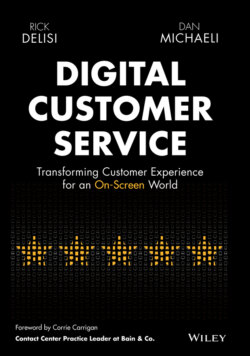Читать книгу Digital Customer Service - Rick DeLisi - Страница 7
Foreword
ОглавлениеYou could say that customer service runs in my blood. My mother started her career working in the American Airlines reservation center, moving her way up through the organization before continuing on to lead customer service operations and consulting teams at companies like EDS and AT Kearney.
My first job in high school was as a telemarketer, calling people just as they sat down for dinner to ask if they wanted to subscribe to HBO (they loved me). My first job out of college was with a major US contact center outsourcer, and I've been in customer experience and contact center consulting for the last 20+ years.
Over this time, I've watched as contact center technology and operations evolved slowly and iteratively, focusing on incremental changes to minimize handle time and reduce the cost per minute of live interactions. But the rate of change has accelerated dramatically in the last six to seven years, and companies have struggled to keep up as:
New interaction channels were added, requiring new investments and increasing the complexity, cost, and fragmentation of customer service operations
New vendors entered the space, challenging legacy providers to “up their game” by investing in new features and functionalities to stay competitive
Customers increasingly compared their experiences across companies – including new digital disruptors like Amazon and Zappos – raising the collective bar for all companies and industries
Enter Digital Customer Service (DCS). But what does that mean, exactly? If you asked five customer experience leaders what DCS is, you'd get five different answers and five very different approaches to how they are achieving this (or hoping to achieve this) within their companies.
DCS isn't about channel proliferation and ensuring your company can interact with customers in any digital channel of their choice. It isn't about enabling customers to do everything via online or mobile self-service. And it isn't about using bots to automate every customer interaction under the sun.
While more and more customer issues are handled (or could be handled) using self-service or some form of automation, there will always be a need for customers to be able to interact with a human to get the more complex and more emotive issues resolved. We call these moments of truth – they are the customer episodes/journeys/intents (pick your term) that have the potential to create a promoter or a detractor based on how they are handled. These are the interactions that present a rare opportunity to deepen and expand the relationship with the customer.
DCS is about how to transform these “moments of truth” from our phone-first, analog past into a future where we leverage the digital devices that have become the omnipresent centerpiece of all of our lives, bringing a new layer of richness and depth to customer interactions.
DCS is about truly “meeting customers where they are” by leveraging the digital entry points that customers tend to use and enhancing the interaction from there in a way that feels seamless, easy, and even delightful to customers.
Companies have been talking about seamless omnichannel experiences for years, yet few have actually achieved this aspiration, even for one-off episodes. Why is that? At the core, it's tied to the operating model of the company – namely that the digital and contact center functions tend to report up through different parts of the organization and often have competing (and sometimes even conflicting) priorities.
Until companies view their own internal processes through the lens of the way customers live their lives today, this will continue to be a challenge and a barrier to providing a truly effortless and seamless customer experience.
Digital Customer Service is for any leader who aspires to integrate digital and contact center strategies in order to take customer experience to the next level.
This book is a helpful tool for:
Establishing a clear and common language for what Digital Customer Service is and its associated component parts
Sizing the benefits of DCS for the company, the customer, and the frontline employee
Developing a plan to make DCS a reality based on the pillars of an effective DCS transformation
I am personally very excited about the next phase in the evolution of customer service and how companies can transform their existing digital and customer service operations to make things better for everyone involved. This book is a meaningful step in that direction and will set the foundation for what great Digital Customer Service can and should look like.
Corrie Carrigan, Contact Center Practice Leader at Bain & Company
